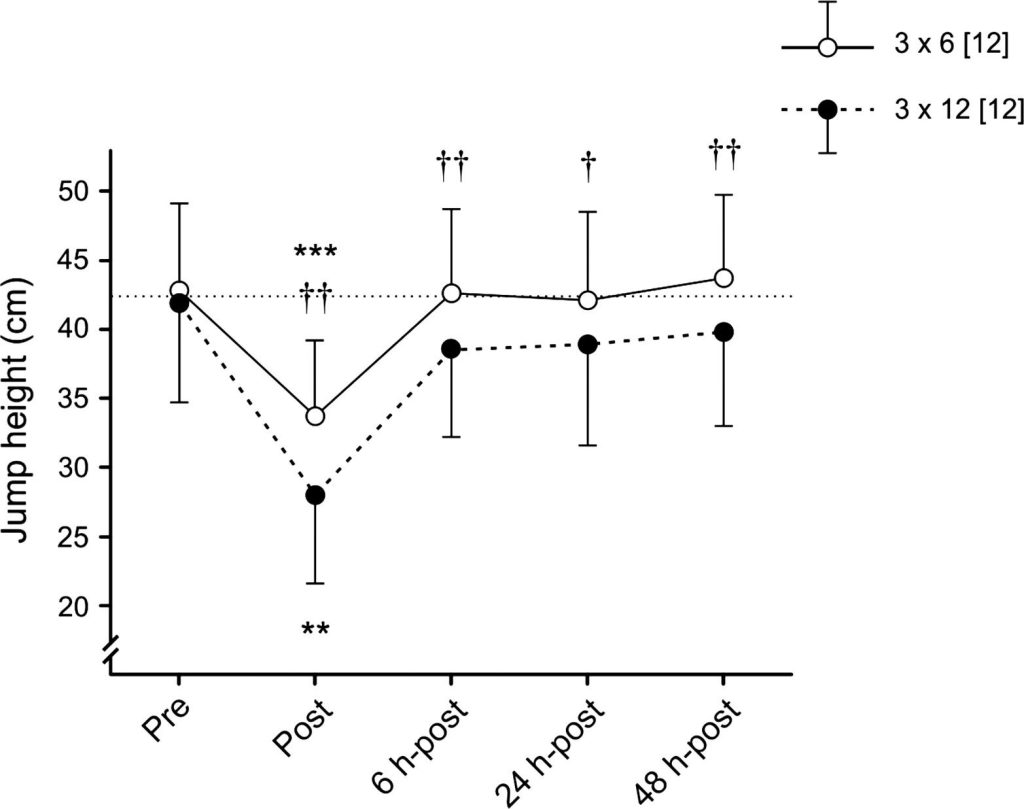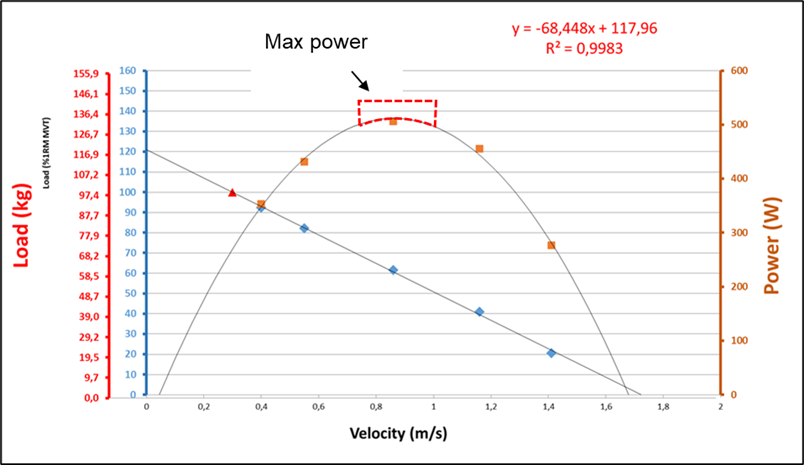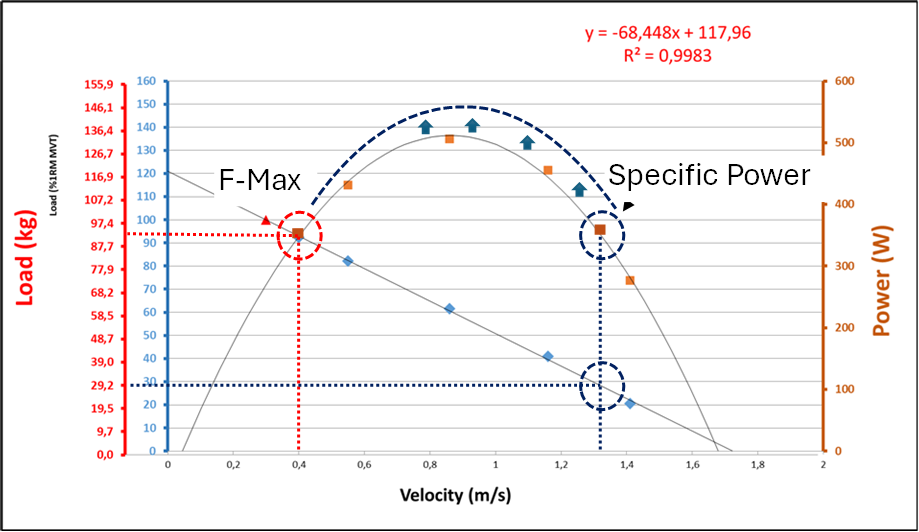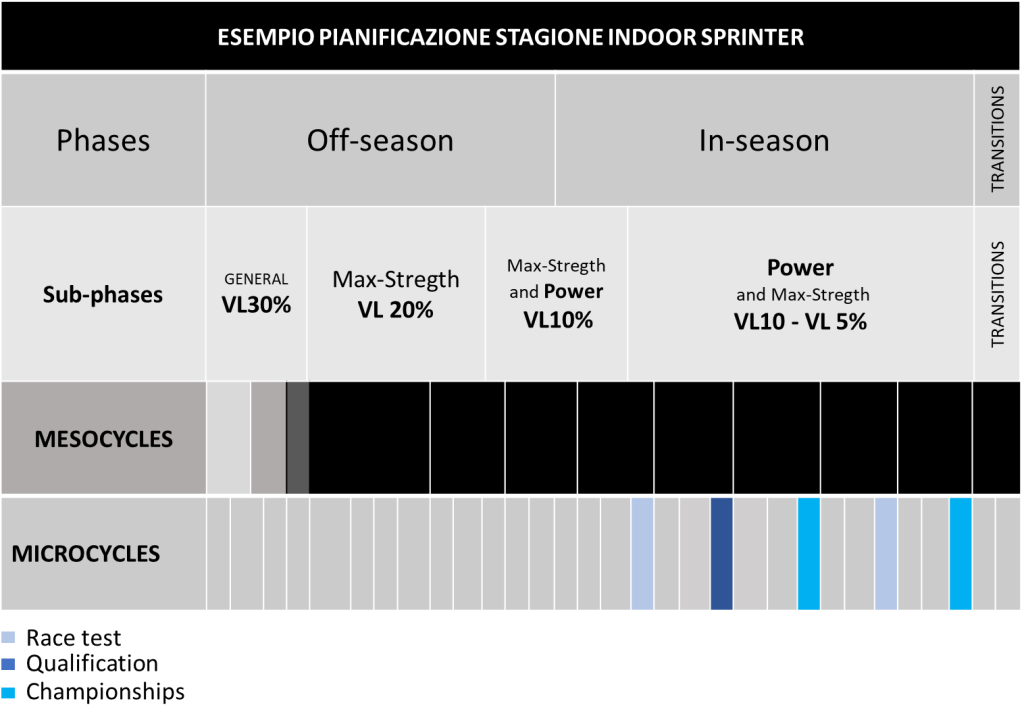11 de February de 2025
Strength and science Velocity Based Training
Creating a Strength and Conditioning Program for Off-Season vs. In-Season
Introduction
Have you ever wondered what makes a successful athlete? Just as Einstein described the nature of the universe with the formula of relativity E=mc², we can describe human performance with a simple formula: Performance = Power / Energy Cost. Physical performance is, therefore, the optimal ratio between power and energy cost, both of which depend on maximum strength. Today, we will focus on when and how to train maximum strength and power.
The Importance of Periodization
Periodization consists of two interrelated yet distinct processes:
- Planning: Define the main goals based on the importance of events.
- Programming: Establish the method and means of training, load, and tapering periods.
Periodization is essential for preparing an athlete for sporting events!
Once the competition schedule is established, it is essential to introduce the various training elements at the right time, using scientifically validated methods and tools such as Velocity- Based Training (VBT) and a linear encoder like Vitruve. Studies have shown that the speed associated with a certain percentage of 1RM is consistent across training sessions and can vary due to fatigue, making the modulation of the Velocity Loss (VL) parameter crucial during training sessions.

Planning
When planning competitive events, priority is given to the most important event. This process varies between individual and team sports. For example, a soccer team will have a short off- season and a long competition schedule, while a sprinter can divide their annual planning into two seasons (indoor and outdoor) to achieve two peaks of form. In both disciplines, training alternates between periods focused on maximum strength (off-season) and power (in-season).
Off-Season vs. In-Season Programming
The main difference between off-season and in-season training lies in the primary goal on which the training program should focus. This program can be modulated through the applied load, the choice of velocity loss determining the volume of work, and the specificity of exercises involving the primary muscles stressed during the technical gesture of the competition activity. The main goal of off-season training is to increase maximum strength. However, this development should not rely solely on hypertrophy training, as training to failure can increase residual fatigue, injury risk, and excessive muscle mass. (1).

You can’t know how far you’re pushing yourself if you don’t monitor Velocity Loss
The concept of Velocity Loss (VL) is a crucial element in training programming. VL represents the reduction in execution speed of an exercise as the athlete becomes fatigued. Training to failure with a VL above 40% can lead to residual fatigue and a higher risk of injury within 48-72 hours after an intense session. (2)

Additionally, this approach can favor the increase of slow motor units at the expense of fast ones, compromising the ability to generate explosive power (3). Therefore, it is essential to modulate VL to optimize strength and power gains without compromising athlete performance and safety. Using velocity (with a linear encoder like Vitruve) to monitor and guide exercise prescription allows for an increase in maximum strength by reducing the volume of work by up to 40%, improving individualization and control of training responses.
Unlike the percentage-based method of 1RM, the VBT method considers fluctuations in maximum strength levels by monitoring speed during warm-up and training sessions. This way, the athlete or coach can adjust the external load during the session simply by referring to the average speed of the previous set or the first repetition of the next set, ensuring the load is appropriate throughout the training (4)
Alternatively, this information can guide the end of a training session, indicate fatigue if an athlete fails to maintain the required speeds, and allow flexible or fixed sets and repetitions schemes, such as training to a 20% velocity loss. Flexible programming takes into account different fatigue rates, differences between athletes, and their daily availability, improving the consistency of speed and power. For example, block periodization models using VBT can start with 30% velocity loss thresholds, follow with a strength mesocycle and a 20% threshold, and conclude with 10% thresholds, reducing fatigue and ensuring greater power.
Off-Season: From Leisure to Power!
Since athletes participate in various activities beyond strength training, managing fatigue is crucial for coaches. Using relative velocity loss thresholds with VBT, it is possible to manage fatigue accumulation and obtain more consistent responses among athletes.
During the off-season, there are two phases: the first with general goals and the second with specific goals. The first phase focuses on increasing endurance and intermuscular coordination using loads from 65 to 75% of the maximum, with velocity loss up to 30% (VL30%).
At this stage, the primary focus should be on ensuring the correct execution of movements. Depending on the duration of the general phase, it is beneficial to incorporate a slow eccentric phase (lasting up to 3 seconds) and a quick concentric phase (about 1 second) before implementing maximal intent. This approach helps strengthen the muscle-tendon junctions, reducing the risk of injuries. For younger and less experienced athletes, the general phase should be extended. It is advisable to include isometric phases and a diverse range of exercises to prepare them for intramuscular coordination training
Intramuscular Coordination for Increasing Strength
This aspect of strength enhances the ability to recruit motor units, reduce inhibitory factors, and increase motoneuron firing frequency, all of which contribute to increased maximum strength (5). Loads should exceed 75-80% of the maximum, and the concentric phase should be executed with maximum intent, following VBT principles.
Monitoring repetitions with Vitruve allows tracking of mean speed between 0.6 and 0.4 m/s. Additionally, during these weeks, velocity loss should not exceed 20% for the lower limbs and 30% for the upper limbs (VL20-VL30%). Avoid accumulating residual fatigue for subsequent field training.
How Long Does Maximum Strength Training Last?
Maximum strength training should never be entirely stopped but rather maintained with reduced volume and fewer sets. If the off-season is long, strength training blocks can last up to 12 weeks. In the case of short off-seasons, at least 4 weeks are required to obtain significant benefits (6).
Maintain Maximum Strength Between Off and In-Season!
Before the competitive phase or in-season, training programs should incorporate power training with loads tailored to the sport’s specific demands. The transition from a mesocycle dedicated to maximum strength to one oriented towards specific power involves gradually increasing the number of power training sets while reducing maximum strength training sets. For instance, alternate squat sets with an average speed of 0.5 to 0.4 m/s and a velocity loss (VL) of 20% with sets averaging 0.8 to 1.0 m/s and a VL of 10%, as shown in Figure 2.

Transition phase
During the transition period from a mesocycle focused on Maximum Strength to one aimed at specific power, the number of power training sets should increase, while the sets dedicated to maximum strength should decrease. As previously mentioned, specific power training requires loads tailored to the sport being practiced. For instance, a soccer player does not need to maintain loads with speeds between 0.8 and 1.0 m/s. Instead, they can focus on what Bryan Mann defined as Speed-strength (1.0 to 1.3 m/s) and Starting strength (greater than 1.3 m/s)
In-Season
During the competitive season, it is crucial to maintain the maximum strength levels achieved during the off-season. At the same time, it is essential to focus on specific power expression through ballistic exercises and movements that closely mimic the technical gestures of the sport.
To illustrate the principle behind this method, we refer to our power curve, which resembles a bell curve and has unique characteristics, as shown in Figure 3

Figure 3. The dashed lines represent the training intensities for Strength and Power, along with their corresponding average speed values. Additionally, the potential upward and rightward shifts of the regression line, which illustrate the indicated Force-velocity relationship and power curve, are also shown.
Training with the contrast method, initially introduced in track and field by Gilles Cometti as the French Contrast Method, involves alternating sets with heavy loads and sets with lighter loads within the same session. The heavy load sets should be greater than 80% of 1RM, with a mean velocity around 0.4 m/s (as shown in Figure 3). According to VBT in-season principles, a velocity loss threshold of 10% should not be exceeded during these sets. Heavy sets should be alternated with lighter sets designed explicitly for explosive power, using loads from 20-30% of 1RM, depending on the type of power to be stimulated, to plyometric exercises and a mean velocity greater than 1.3 m/s. For the “power” exercises, it is recommended to avoid a velocity decline of more than 10% within a set on most occasions. However, when peaking or tapering, a figure of 5% may be more appropriate (2,7).
As you progress to more important competitions, you will need to increase the number of power and speed sets at the expense of maximum strength sets. This approach allows for the transfer of maximum strength work performed during the off-season to power, shifting the power curve upward and to the right without excessively losing maximum strength levels.
It is important to emphasize that ballistic training, including the plyometric method, cannot be suddenly introduced during the competition season. Instead, it must be planned in a light form as early as the general off-season phase. Initially, volumes should be increased, followed by intensity. As the off-season progresses, the prerequisites for high-intensity, low-volume plyometric work are established.

Figure 4: Example of Periodization
Conclusion
In conclusion, here is an example of periodization and programming for an indoor season (e.g., for a sprinter), designed to help you understand, apply, and customize off-season and in-season training using the VBT method.
See you in the next blog!

References
1 Bompa, T. O., & Buzzichelli, C. (2019). Periodization-: theory and methodology of training. Human kinetics.
2 Sánchez-Medina L, González-Badillo JJ. Velocity loss as an indicator of neuromuscular fatigue during resistance training. Med Sci Sports Exerc. 2011 Sep;43(9):1725-34. doi: 10.1249/MSS.0b013e318213f880. PMID: 21311352
3 Pareja-Blanco F, Rodríguez-Rosell D, Sánchez-Medina L, Ribas-Serna J, López-López C, Mora-Custodio R, Yáñez-García JM, González-Badillo JJ. Acute and delayed response to resistance exercise leading or not leading to muscle failure. Clin Physiol Funct Imaging. 2017 Nov;37(6):630-639. doi: 10.1111/cpf.12348. Epub 2016 Mar 11. PMID: 26970332.
4 González-Badillo JJ, Yañez-García JM, Mora-Custodio R, Rodríguez-Rosell D. Velocity Loss as a Variable for Monitoring Resistance Exercise. Int J Sports Med. 2017 Mar;38(3):217-225. doi: 10.1055/s-0042-120324. Epub 2017 Feb 13. PMID: 28192832.
5 Suchomel TJ, Nimphius S, Stone MH. The Importance of Muscular Strength in Athletic Performance. Sports Med. 2016 Oct;46(10):1419-49. doi: 10.1007/s40279-016-0486-0. PMID: 26838985.
6 Del Vecchio A, Casolo A, Negro F, Scorcelletti M, Bazzucchi I, Enoka R, Felici F, Farina D. The increase in muscle force after 4 weeks of strength training is mediated by adaptations in motor unit recruitment and rate coding. J Physiol. 2019 Apr;597(7):1873-1887. doi: 10.1113/JP277250. Epub 2019 Feb 6. PMID: 30727028; PMCID: PMC6441907.7 Sekulović, V., Jezdimirović-Stojanović, T., Andrić, N., Elizondo-Donado, A., Martin, D., Mikić, M., & Stojanović, M. D. M. (2024). Effects of In-Season Velocity-Based vs. Traditional Resistance Training in Elite Youth Male Soccer Players. Applied Sciences, 14(20), 9192. https://doi.org/10.3390/app14209192
